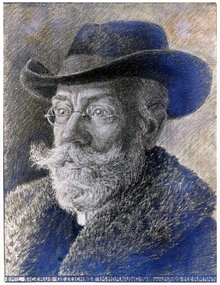Emil Sigerus
Emil Sigerus (born February 19, 1854 in Sibiu , Austrian Empire ; † March 25, 1947, same place, Kingdom of Romania ) was a Transylvanian-Saxon folklorist, art collector and city historian.
Life
In addition to his job as an employee and later director of the Transsylvania insurance company , from 1880 he was also the editor of the Transylvanian-German daily newspaper in Hermannstadt, the most important newspaper of the Transylvanian Saxons at the time.
A great achievement of Sigerus was that he recognized the value of Transylvanian-Saxon folk art (ceramics, pewter vessels, carpets, textiles, embroidery) and the uniqueness of the fortified churches in Transylvania very early on. And that at a time when people were more eager to dispose of the "old junk" and some villages were starting to demolish the fortifications of the fortified churches in order to gain space and building material for new buildings. With his picture album, Transylvanian-Saxon Castles and Church Fortresses , published in 1900 , he made these monuments widely known and achieved a rethink to protect them.
His most important works include the chronicle of the city of Sibiu and Vom alten Hermannstadt (3 volumes, 1922–1928). Other publications were devoted to the history and folklore of Transylvania. Incidents that he had heard or read in old chronicles and writings appeared collected as Von alten Menschen und alten Zeiten in two volumes in 1937. These books are not considered to be scientific historical works, but contain innumerable anecdotes and details from different epochs of the city's history, but always from a Transylvanian-Saxon point of view. During the communist era, these works were therefore temporarily banned and were not allowed to be re-edited or even translated into Romanian.
In 1997, the Emil Sigerus Museum was opened in the house on the Kleiner Ring in Sibiu, formerly known as the " Treasure Box ", with exhibitions of Saxon, Romanian and Szekler folk art.
On the occasion of his 150th birthday, an exhibition was held in the Franz Binder Museum in Sibiu in 2004 .
Fonts (selection)
- Travel guide for Greater Romania . Berlin: Verlag Rüdiger, 1925
literature
- Erna Bedeus: Emil Sigerus. His life and work. State Publishing House for Art and Literature, Bucharest 1958.
- Michael Martischnig: Sigerus Emil. In: Austrian Biographical Lexicon 1815–1950 (ÖBL). Volume 12, Verlag der Österreichischen Akademie der Wissenschaften, Vienna 2001–2005, ISBN 3-7001-3580-7 , p. 251.
- Walter Myss (Ed.): The Transylvanian Saxony: Lexicon: History, culture, civilization, science, economy, living space Transylvania (Transylvania). Kraft, Würzburg 1993, ISBN 3-8083-2018-4
- Brigitte Stephani: important mediator between cultures. Attempt of a monographic sketch on Emil Sigerus. In: New Way (Bucharest). 28/8854, October 30, 1976.
- Brigitte Stephani (Ed.): Emil Sigerus. Folklore and art historical writings. Kriterion, Bucharest 1977.
- Brigitte Stephani: Emil Sigerus, an explorer of Romanian folk art . In: Research on Folklore and Regional Studies (Bucharest). Vol. 22/1979, pp. 93-95.
Web links
- Literature by and about Emil Sigerus in the catalog of the German National Library
- Sigerus, Emil . In: East German Biography (Kulturportal West-Ost)
- Sibiu.ro - Homepage of the Mayor's Office: Emil Sigerus Museum
| personal data | |
|---|---|
| SURNAME | Sigerus, Emil |
| BRIEF DESCRIPTION | Transylvanian folklorist |
| DATE OF BIRTH | February 19, 1854 |
| PLACE OF BIRTH | Sibiu , Austrian Empire |
| DATE OF DEATH | March 25, 1947 |
| Place of death | Sibiu , Kingdom of Romania |

